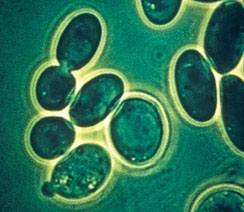The answer is simple: yeast has a
cellular nucleus containing its
DNA in the form of
chromosomes , which is not the case of
bacteria . Yeast is a
living organism . Like those found in humans, yeast cells are living and natural.
The yeast cell is no bigger than a pinhead. Zoom onto the infinitely small.
Yeast is an egg-shaped microscopic cell, not visible to the naked eye. It is scientifically called a "micro-organism ".
There are two types of yeast: natural and chemical. They are not the same thing! Explanations.
There are natural and chemical yeasts . Chemical yeast consists of bicarbonate of soda, potassium hydrogen tartrate and corn starch and does not allow fermentation .
The name "yeast" comes from the fact that these organisms make the bread dough "foam or froth". How does it work?
Yeasts create what is called a fermentation. In this case, it is alcoholic fermentation as glucose (sugar) is transformed into carbon dioxide and alcohol . The released carbon dioxide gives the sparkle to beer and makes bread dough lighter, more airy and therefore less compact.
 The answer is simple: yeast has a cellular nucleus containing its DNA in the form of chromosomes, which is not the case of bacteria. Yeast is a living organism. Like those found in humans, yeast cells are living and natural.
The answer is simple: yeast has a cellular nucleus containing its DNA in the form of chromosomes, which is not the case of bacteria. Yeast is a living organism. Like those found in humans, yeast cells are living and natural. The answer is simple: yeast has a cellular nucleus containing its DNA in the form of chromosomes, which is not the case of bacteria. Yeast is a living organism. Like those found in humans, yeast cells are living and natural.
The answer is simple: yeast has a cellular nucleus containing its DNA in the form of chromosomes, which is not the case of bacteria. Yeast is a living organism. Like those found in humans, yeast cells are living and natural.